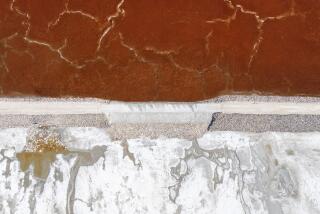Ignoring a Simple Fact in Utah: Deserts Are Supposed to Be Dry
SALT LAKE CITY — Farmers and politicians call Utah’s fourth straight year of below-average snowpack a disaster. But a University of Utah political science professor who writes on Western water issues says that ignores a simple fact: Deserts are supposed to be dry.
“It’s a mistake to talk about the drought as a crisis,” said Dan McCool. “We are always in a drought. That’s the definition of a desert. It’s ignoring that Utah is a desert that’s causing the problem.”
McCool isn’t alone in his thinking. Volumes have been written criticizing the West’s water subsidies that began with the 1902 creation of the Reclamation Act, which guaranteed water for Western farmers and ranchers no matter the cost. But the practice continues: 82% of Utah’s water goes to an industry that accounts for 1% of the state’s economy.
This year’s water shortages are focusing new attention on those figures and the wisdom of farming in the desert. The drought means farm water cutbacks of 50% in northern Utah, and as much as 100% in the southern desert.
Although Salt Lake City, with an average annual rainfall of 16 inches, isn’t considered desert, much of the rest of the state meets the criteria: an empty, arid region with fewer than 10 inches of rain per year, where evaporation exceeds rainfall.
And drought, said National Weather Service hydrologist Brian McInerney, is in the eye of the beholder.
“We try to stay away from that word, because it means different things to different people,” McInerney said.
There are three kinds of drought: climatic, hydrologic and agricultural.
The first two rely on 100 years of statistics but evaluate snowpack levels only for the preceding 30 years when deciding what is average--a tiny time span in general weather patterns, but practical for agricultural and municipal water managers.
An agricultural drought means farmers and ranchers are getting less water than they need to function--a subjective measurement that McCool finds irrational, especially for southern and eastern Utah.
“That’s like saying Canada is short of palm trees,” he said. “We don’t have a water problem in the West. We have an agricultural-subsidy problem.”
An acre-foot of residential water--about 326,000 gallons, roughly enough to serve the needs of an average family of five for one year--costs Utah households about $320, said Larry Anderson, the state’s director of water resources.
Depending on the efficiency of the irrigation system, an acre of alfalfa needs from 2.7 to 6.5 acre-feet of water per crop. Center pivot sprinkler irrigation uses the least water, flood irrigation the most.
Because most urban water is used on landscaping, water officials are urging conservation methods such as limited sprinkling and landscaping with drought-tolerant plants. Sometimes their suggestions imply that saving water in Salt Lake will help drought-stricken farmers to the south, but that’s not possible. The water systems aren’t connected.
Northern Utah water users rely on stream flow from the mountains to the east; they pay about $5 per acre-foot for their irrigation water, Anderson said. Southern Utah farmers get their water from the Colorado River for about $10 per acre-foot. “That’s probably the most a farmer can pay and still make a profit,” he said.
Because farmers hold rights to a certain amount of water, there’s no incentive to conserve, even in the desert. If reservoirs are full, farmers grow extra crops. Utah doesn’t even use all of its Colorado River allotment, because there aren’t enough dams to capture it.
Agriculture’s contribution to the state’s economy hovers at 1%, according to Neil Ashdown of the governor’s management and budget office.
Subsidizing such a small industry “is doing a great disservice to the taxpayers of America,” McCool said. “I am not suggesting that we pull the rug out from under all [farmers and ranchers], but it’s time for them to become self-sufficient.”
Cary Peterson, Utah agriculture commissioner, defends farming as crucial to the state’s economy and well-being, especially in rural areas.
“If desert is all you have for the families in a community, farming makes the difference between whether you eat or not,” he said.
To farmers, drought or not, getting the water they need is a fundamental guarantee.
“Water in Utah is a property right,” Peterson said. “Those rights were established very early in the West.”
Desert farmers grow high-value fruits and vegetables for export, as well as high-protein alfalfa--the foundation of the livestock industry, which makes up 76% of Utah’s agriculture economy. Alfalfa also serves to stabilize the soil in the fragile desert environment.
McCool, however, singled out alfalfa as a Utah crop that would be extinct without water subsidies because the cost to grow it is greater than its market value.
“There’s this ideal of farmers who work hard--and they do, they are the hardest-working people and the least economically viable--and that’s why we keep subsidizing them,” McCool said.
In Utah, where pioneer farmers are a source of pride, tradition likely always would trump practical economics.
“We know [desert farmers] are going to grow crops ‘til the day they die,” said National Soil Conservation Service representative Kresha Eastman.
Roger Barton, whose irrigation district in the southeastern Utah town of Ferron is taking advantage of federal subsidies to build a more efficient sprinkling system, said that of the 300 farmers in his district, only one relies entirely on farming to survive.
The rest have jobs on the side. “That’s still hurtful, to have to admit I’m not a full-time farmer,” Barton said.
In the face of this drought and the certainty of more to come, Barton acknowledged that farming in the desert can seem crazy.
“There’s so many of us who have that passion. If only we could just make it,” he said. “There’s always hope for next year.”
More to Read
Sign up for Essential California
The most important California stories and recommendations in your inbox every morning.
You may occasionally receive promotional content from the Los Angeles Times.










